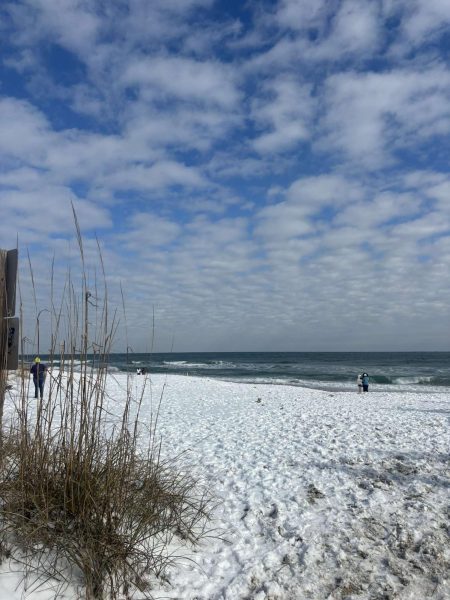UNCW professor plays hand in a controversial plan to manage southern flounder population
The North Carolina Marine Fisheries Commission (MFC) convened on March 3 to go over amendments for the Southern Flounder Fisheries Management plan.
Several of the decisions made at the conference proved to be controversial. Percentages of how much of the total season catch can be harvested by each sector were adjusted to 70% for commercial fishermen and 30% for recreational fishermen, a figure that fishermen on the recreational side say will result in a shorter season for them than years past. The rejection of a proposed moratorium on all southern flounder harvest put forth by Commissioner Pete Kornegay was also drawing attention, apparently due to the motion being put forward without prior notice to the members of the commission.
The plan was conceived in late 2017 out of a need to protect North Carolina’s population of southern flounder, which is listed as a “near threatened” species on the International Union for Conservation of Nature’s red list. Stock assessments of southern flounder revealed that overfishing occurred historically, and is continuing into the present, resulting in the need for a more stringent management plan.
Fisheries management plans are largely responsible for determining things such as what type of fishing gear can be used, how it is used, length of fishing seasons and where fishing can and cannot be done. In North Carolina, this power is delegated to the MFC by the Division of Marine Fisheries (DMF), a branch of the Department of Environmental Quality.
One of the commissioners who has assembled the current plan is Martin Posey, a UNC Wilmington (UNCW) professor of marine biology and director of the Center for Marine Science, who holds a doctorate in biology from the University of Oregon.

“Historically the recreational harvest has been about 27% of the catch while the commercial harvest has been about 73%,” said Posey on the sector allocations. “This is controversial, and I would firmly agree that the allocations should change alongside the industry. The question for me is that should these changes come immediately, or should it come as we learn more about the lives of the fish.”
David Sneed, executive director of the North Carolina branch of the Coastal Conservation Association, made the claim that the allotments were created off of data that is out of date.
“In making a decision to go to that new allocation, the division of marine fisheries used 2017 as their historical landings split,” said Sneed. “If you go back a few decades, the commercial sector used to harvest 85% to 90% of the stock. As the stock has shrunk, the split has gotten closer together, with the last five years being around 65% commercial and 35% recreational.”
When asked about the impacts this will have on the recreational fishing industry, Sneed painted a bleak picture.
“This takes recreational fishermen back a few years from where we are currently. There are more recreational fishermen coming out than ever before, and they’re fishing an increasingly shrinking stock of flounder,” said Sneed. “There wasn’t enough discussion at the meeting about the impacts of what they were doing, just a rushed vote.”
As for the moratorium, that would have seen a stopping of all southern flounder harvest in order to replenish the depleted population. Posey insisted that procedural issues stopped the motion in its tracks.
“For major changes in the fisheries we are supposed to have a period where commissioners and public agencies can respond, rather than it coming right onto the floor. But this could definitely be something that we see come back,” said Posey.
Posey then touched on the importance of learning more about the southern flounder to aid in decision-making.
“We do not know what they do when they go offshore to spawn, we don’t know how interconnected the populations are,” said Posey. “We need to know if the fish that spawn here go elsewhere, or if the ones that we see here spawn in South Carolina or Georgia. That is an important piece of information that we do not know, and that we simply need to know.”

When asked about whether a moratorium should be temporarily enacted until more is learned about the population, Posey seemed uncertain.
“That’s a good question, and I am not quite ready to say yes or no,” said Posey. “It is very unpopular with both commercial and recreational fishermen. There is a very strong cultural aspect when it comes to the flounder. There really is much that we don’t know, but we are trying to find out.”
Rather than overfishing, Posey posited that habitat destruction due to a changing climate is the most detrimental to the southern flounder, as well as thousands of other species.
“For North Carolina in particular, sea level rise, storms, the Outer Banks will no longer be there, then what will we have in Pamlico Sound, what will there be in Albemarle Sound, it will be changed fundamentally” said Posey.
“The estuarine areas that flounder reside in simply will not be there. With saltwater intrusion, loss of protected areas, everything will be changed. There will be major habitat loss of already fragile ecosystems. I understand that climate change may be controversial for some, it is not for me. It is happening.”












Tommy McArthur • Aug 25, 2021 at 9:15 am
That migration data does exist for spawning and shows the fish do migrate. Some which were tagged in Neuse river were caught in South Carolina as well as Georgia. All this data is in fact available from NCDMF. The CCA has an agenda they are pushing and it is wrong for them to try to dictate to the people of this state what goes on in public trust waters.